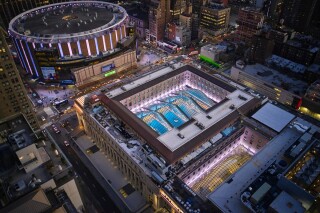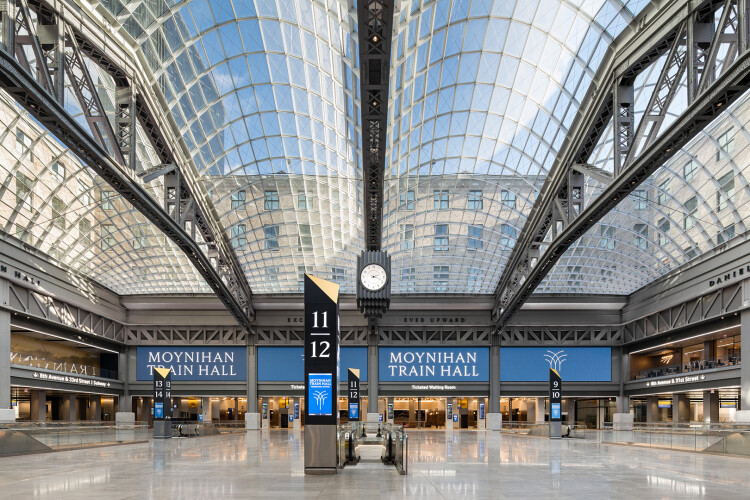The project, which created more than 5,000 construction jobs, followed on from Skanska earlier role on the scheme’s US$220m initial phase.
The project has involved the transformation of the James A Farley Post Office Building into the new 225,000-square-foot Moynihan Train Hall for Empire State Development. The mixed-use hall is located directly across Eighth Avenue from the existing Penn Station, which serves Long Island Rail Road (LIRR) and Amtrak passengers.
The project has transformed what is believed to be the busiest transportation hub in the Western Hemisphere. Designer SOM said that the project brings light to the concourses for the first time in more than 50 years, increases total concourse space by 50%, and restores the grandeur that was lost with the demolition of the original Penn Station half a century ago.
Commuters now have improved access to nine platforms and 17 tracks, as well as a direct connection to the Eighth Avenue Subway and a new entrance to the station complex on Ninth Avenue.
The centrepiece of the building is a 28m-high glass canopy roof and skylight letting natural light and air into the space. The train hall also offers 700,000 square feet of new commercial, retail and dining space.
Skanska has worked in and around the historic James A Farley Post Office Building since 2012, starting with the US$220m Moynihan Station Phase 1 project. This involved expanding and modernizing the West End Concourse at Penn Station to link with the Farley Building, improving passenger circulation and capacity for nine of the station’s 12 train platforms. Skanska’s work on Phase 1 led to developers Vornado Realty LP and The Related Companies selecting the company as general contractor for the $1.6 billion Moynihan Train Hall.
“The new Moynihan Station is a symbol of the region’s bright future and general optimism, and we are honoured to contribute to Governor Andrew M Cuomo’s goal of providing the city with the world-class transportation systems it deserves,” said John Sullivan, senior vice president of operations for Skanska USA Civil. “We thank the hundreds of craft workers that safely and diligently accomplished this project on time and on budget—even in the midst of a global pandemic. Infrastructure is vital to building a strong economy and we are proud to have had the opportunity to greatly improve access to and from the city for the people of New York."

The restoration of the Farley Building to create the new Moynihan Train Hall included:
- the renovation of 1.4 million square feet of transit, retail, and commercial office space, which included the restoration of the building’s original, historic façade;
- the construction of the 28m-high skylight that spans about an acre above the former post office’s historic steel trusses and new concourse level. This required the installation of nearly 2,200 individual glass panels;
- major demolition of existing structural and architectural elements, removal of asbestos and lead abatement, as well as a structural steel reinforcement and rehabilitation of the building’s mechanical and electrical systems;
- provision of upgraded lighting and wayfinding and digital screens.

“This is an incredibly important moment in the history of New York City,” said SOM partner Colin Koop. “We’ve designed a place that evokes the majesty of the original Penn Station, all while serving as a practical solution to the issues that commuters in, to and from New York have endured for too long. By connecting to our architectural past through the adaptive reuse of the Farley Post office building, we are breathing new life into New York, and recreating an experience no one has had here in decades.”
SOM managing partner Laura Ettelman added: “SOM has been working on this project since 1998 - for more than two decades. Our deep commitment to this project has been fuelled by the profound belief that New York City is better because of projects like this.”
That original Pennsylvania Station was designed by McKim, Mead & White in 1910. SOM described it as a skylit, Beaux-Arts masterpiece that celebrated travellers’ arrival to New York City. After its demolition in 1965, only its concourses and platforms remained, and they were all underground in a space downgraded to accommodate only 200,000 people. Five decades later, the number of people passing through the station every day swelled to more than 600,000, while the Farley Building – also designed by McKim, Mead & White in 1913 – had become 95 percent vacant. The Farley Building, residing above Penn Station’s tracks, was seen as the perfect place for a new train station.
“One of the most remarkable things about this project is the way that it transforms an under-utilised and under-appreciated building into a new, inviting front door for this city,” said Roger Duffy, the retired SOM Design Partner who led the project for the firm. “The train hall is at the core of this transformation. It is designed with lightness and warmth, which combine to reestablish the essence of what it means to come to New York.”
Got a story? Email news@theconstructionindex.co.uk
.png)


